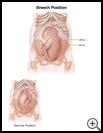
Breech Position
________________________________________________________________________
KEY POINTS
- A breech position means that the baby's bottom or feet will come out before the head when the baby is born. This can cause problems during delivery. The baby’s head may get stuck inside the uterus, and the baby could be injured or die.
- If your baby is in a breech position after 36 weeks, your healthcare provider may try to turn the baby. If your baby does not turn and is still breech, your provider may recommend a cesarean delivery (C-section) to avoid problems for you and the baby.
________________________________________________________________________
What is a breech position?
By the time a pregnancy reaches full term, most babies are in a position in the uterus that will allow their head to be delivered first when they are born. However, in some pregnancies, the baby is bottom first. This is called a breech position. It means that the baby's bottom or feet will come out before the head when the baby is born. This can cause problems during delivery.
The breech position is common in early pregnancy. About one third of all babies are in a breech position at 24 weeks. However, most babies are in the head-down position by the 32nd week. When there are twins, often one of them is in the breech position close to the due date.
Why is a breech position dangerous during delivery?
The head is the largest part of the baby that must fit through the birth canal. During a normal head-first delivery, there is time during labor for your baby's head to slowly shape itself so that it can pass through the birth canal more easily.
When your baby is breech, the baby's bottom, instead of the head, is first to go through the birth canal. Once the bottom has been delivered, the baby’s belly, chest, arms, and head follow quickly. This does not allow enough time for your baby's head to shape itself to fit through the cervix (opening to the birth canal) and then through the birth canal. The cervix may close around the baby's neck, so that the baby’s head gets stuck inside the uterus.
If your baby’s head is having trouble moving into the birth canal, a vaginal delivery may be dangerous or impossible. The baby could be injured or die.
How will I know if my baby is breech?
Usually it’s hard for you to know your baby’s position. If your baby is breech, you may feel the baby's head moving under your rib cage. Or it may feel like you have a hard knot under your ribs. You may also feel the baby kicking low in your pelvis.
Your healthcare provider may find that the baby is breech by feeling the baby's head through your belly or by feeling your baby’s feet or bottom during a pelvic exam. Your provider may hear the baby's heartbeat above your belly button rather than in your lower belly.
An ultrasound exam, which uses sound waves to show pictures of the baby, can show the size of the baby and the position of the head.
What happens if the baby is in a breech position close to the due date?
If your baby is in a breech position after 36 weeks, your healthcare provider may try to turn the baby. Your healthcare provider will put his or her hands on your belly and find the baby's head. Your provider will then gently press on your belly to push the baby into a headfirst position.
If this doesn’t work, your healthcare provider will leave your baby in the breech position until you deliver. There’s a good chance that your baby will change position by the time labor begins. If your baby does not turn and is still breech, your provider may recommend a cesarean delivery (C-section) to avoid problems for you and the baby.
You may be able to have a vaginal delivery if you are having twins and the first baby delivers head first and the second twin is not larger than the first twin. The first baby may be able to stretch and open the birth canal enough to allow the second baby to pass through. Your healthcare provider may reach inside the uterus after the first baby is born, grasp the second twin’s feet, and pull the baby out.
Vaginal delivery of a breech baby may also be possible if:
- You have had a previous successful vaginal delivery of a baby that was the same size or bigger.
- Your healthcare provider has experience in delivering breech babies.
- A delivery room and staff are ready to do an emergency C-section if needed.
- The size of your pelvis is large enough to deliver a breech baby. Both you and the baby are doing well before and during labor.
- Your baby weighs between 5 and 8 pounds and ultrasound shows that the baby is in a good position for a vaginal breech delivery.

